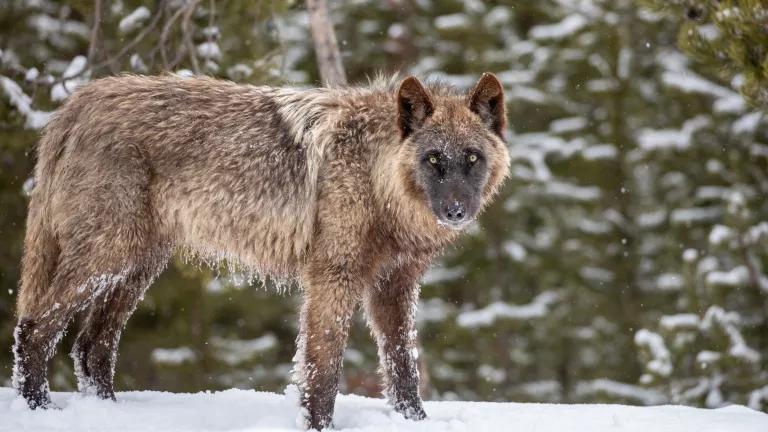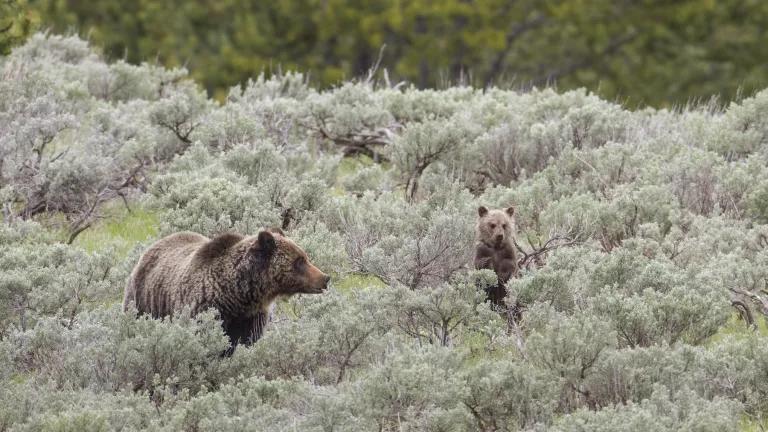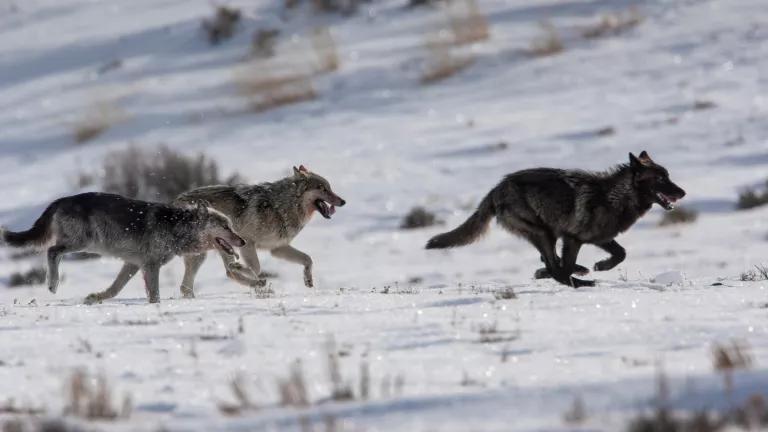Not Even Yellowstone Wolves Are Safe from State Persecution
The growing death toll for Yellowstone wolves is a revealing microcosm of the larger mismanagement of wolves occurring across multiple states.

A gray wolf from the Wapiti pack standing in the snow in the Firehole area of Yellowstone National Park, Wyoming.
The wolves of Yellowstone National Park are some of the most observed, most studied and most beloved wolves in the entire world. This year, they are being deliberately targeted and killed in the states surrounding the park.
On the days I’ve felt most beaten down by the environmental, social and public health crises of our time, I have ventured a couple hours from home into Yellowstone National Park to watch wolves as they play, howl, sleep, hunt and live out their lives free from the anxieties that plague modern society. I have deepened my understanding of the natural rhythms of life by observing these wolves engage in an ancient predator-prey dance that is essential to a healthy ecosystem. Like millions of other park visitors, I have been enriched and inspired by immersing myself in the wildness of the Yellowstone landscape—exemplifying the very mission of the National Park Service.
Disturbingly, not even Yellowstone wolves are safe from misguided state efforts to reduce wolf populations. At least 20 park wolves have been killed during the current wolf hunting and trapping season after they stepped foot across the invisible park border into the surrounding states—15 in Montana and 5 more in Idaho and Wyoming. This accounts for 15-20% of the park’s total wolf population and more will surely die as the season drags on. Wolf hunters and trappers have deliberately patrolled the park border in pursuit of Yellowstone wolves. Such hostile and unethical approaches are not representative of the larger hunting community and some hunters say it's giving Montana a black eye. Still, these extreme views have prevailed in shaping wildlife policy.

A trail of wolf paw print tracks in the snow on Fountain Freight Road in Yellowstone National Park.
Montana and Idaho loosened restrictions on killing wolves in 2021, driven by politicians who legalized antiquated tools such as baiting, snaring and even bounties to enable and incentivize a reduction of the wolf population. Montana also did away with the quotas in the hunting units that border the northern part of the park. This means that in areas where only one wolf could be killed per season in past years, there is now no limit on how many wolves can be killed. Under the grimmest of possible scenarios, an entire Yellowstone wolf pack could be legally lured across the park boundary with bait and killed by just one or two hunters. Concerned citizens turned out in droves to oppose these new aggressive measures, but decision-makers have prioritized the desires of a politically powerful vocal minority at the expense of the larger public and the integrity of the state’s wildlife management approach.
Around one percent of Montana residents purchase a license to hunt or trap wolves per year. An even smaller proportion will actively participate in pursuing wolves. Yet hunters, trappers and government agents typically kill around 30% of the state’s wolf population, which has been estimated to total ~850 to ~1,200 wolves according to recent models. And, in Idaho, where the wolf population was estimated to total ~1,500 wolves in 2020, around 500 wolves were killed during the 2021 calendar year.
Park wolves learn from a young age that humans are not a threat. Many of these wolves have had crowds of people—sometimes in the hundreds—watching them from the moment they emerged from their den. This has made them less wary, and easier to kill, than wolves living outside of a protected area. Perhaps this explains why ~10% of the wolves killed statewide in Montana by early January (at the time of publication) have been wolves that lived out their lives primarily inside Yellowstone National Park. The disproportionate impact on the park's wolf population has been striking.

Gray wolves peer through a car window in Yellowstone National Park.
Yellowstone hosted nearly 4.5 million visitors in 2021. The chance of seeing wolves and other rare wildlife is a huge draw. Wildlife guides, photographers and local business owners who operate in and around Yellowstone National park recently called for reinstated protections for wolves in the Northern Rockies, citing the impacts of wolf killing on their businesses, jobs and local tourism and recreation economies. Research has shown—unsurprisingly—that killing wolves in areas adjacent to parks can reduce wolf sightings within the parks, even when there is little impact on the overall population size.
Many thousands of park-goers will enjoy a rare opportunity to watch wolves during the course of a single season in Yellowstone, and these same animals have provided outsized value to the scientific study of wolf behavior, dynamics and ecology. While management authority over wildlife can shift between the federal government and state governments depending on land ownership, killing wolves that step (even briefly) outside of the park’s boundaries disrespects and harms the mission of the National Park Service, the world-renowned Yellowstone wolf research project, and the American public that shares in proud ownership of our national parks and wildlife.

The spectacular Yellowstone landscape was set aside in 1872 as the world's first National Park to be held in trust for all citizens, though it had been inhabited and held sacred by Native Americans for thousands of years.
The recent push to kill more wolves in Montana and Idaho has been driven by a larger political machine fueled by an anti-predator campaign. Misinformation and fear mongering are pervasive, including the assertion that wolves are decimating elk populations that are desirable to hunters. But while wolves are being killed across western Montana, state wildlife managers are embroiled in conflict over the best means to reduce elk populations that have ballooned beyond the state’s intended objectives in some of those same areas. The justifications that have been repeatedly used to push for extreme wolf killing ring hollow, and the ecological and social value of wolves has been repeatedly ignored.
The growing death toll for Yellowstone wolves is a revealing microcosm of the larger mismanagement of wolves occurring across multiple states. In order to restore science, integrity and democracy to wildlife management, Interior Secretary Haaland should restore federal protections to wolves in the Northern Rockies.
Take action below to ask Secretary Haaland to protect Yellowstone wolves and all wolves in the Northern Rockies from senseless killing. And if you are a resident of Montana, contact Governor Gianforte to let him know that you oppose the extreme direction the state has taken with wolf management and urge him to take immediate action to prevent the loss of more Yellowstone wolves.



